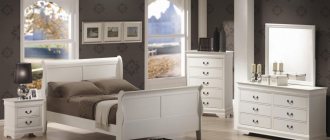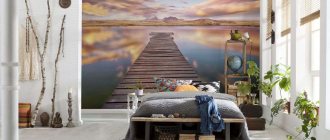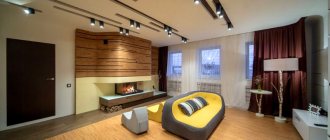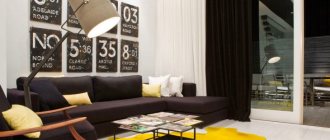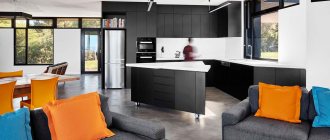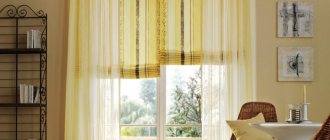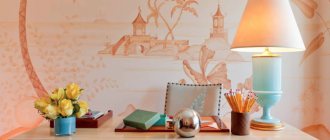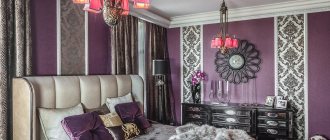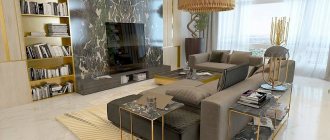Repair is not only a troublesome task, but also quite educational. In order for the entire interior design to turn out beautiful and harmonious, it is necessary to correctly combine all the details.
You can turn to professional designers for help, but you will have to pay extra. Or you can independently study all the nuances and recreate a unique design. Let's consider the main modern trends and types of wallpaper for the living room.
Today, the range of wallpapers is very diverse and large. It seems that choosing the appropriate option will not be difficult. But you shouldn’t take your upcoming purchase so lightly. It’s so easy to get confused in the options offered.
The main types of wallpaper for the living room can be formed into the following types:
- With flowers;
- Striped;
- Combined;
- Modern wallpaper;
- Photo wallpaper.
There really is so much to choose from. Next, we will analyze each type in more detail, but for now we will give general recommendations for choosing wallpaper for the living room.
1. You should choose only high-quality wallpaper. They are environmentally friendly and will not accumulate dust and quickly fade. 2. Living room - a room for meeting guests. The entire interior should be stylish, and all details should be in harmony with each other. Therefore, you should buy wallpaper that matches the overall style of the room. 3. You should not choose wallpaper that is too dark or, conversely, white. Golden shades or green are better. 4. Wallpaper must be resistant to fading and also prevent the accumulation of dust.
Types of wallpaper
Many people, when choosing wallpaper, first of all pay attention to its aesthetic qualities and completely forget about practical properties. We advise you not to follow this example and decide first of all what type of paintings will best suit the design of your living room.
Paper wallpaper for the living room
Such wallpapers can rightfully be called “oldies” among finishing materials. At the same time, they have not lost their popularity primarily due to their low cost.
And secondly, unlike their ancestors, today’s paper wallpapers have a large number of design interpretations, thanks to which you can make a beautiful, stylish renovation without investing a lot of money. Of course, their strength indicator is inferior to vinyl and other materials, but in a living room this is not so important.
Non-woven wallpaper for the living room
A modern type of wallpaper with increased moisture resistance and the ability to withstand mechanical stress. Non-woven wallpaper comes in several types, among which textured wallpaper, designed for painting, and also with vinyl coating are very popular. The latter have a special decorative effect, having designs, patterns and excellent varied texture.
Glass wallpaper for the living room
An interesting material that contains fiberglass. Such wallpaper is practically resistant to dirt, humidity, and temperature changes. All this suggests that glass wallpaper is very convenient to glue not only in the living room, but also in the kitchen area, if the rooms are combined. The canvases have a relief, they can be easily painted and repainted up to 15 times.
Liquid wallpaper for the living room
An amazing coating that, in fact, can hardly be called wallpaper. Their consistency and method of application are more reminiscent of decorative plaster. A rich palette of colors, as well as various additives, allow you to reproduce drawings, abstractions, and luminous effects on the wall, creating with your own hands a unique coziness in the living room interior.
Natural wallpaper for the living room
This is the category of the most respectable coverings, the basis of which is fabric, leather, bamboo or balsa wood. Natural wallpaper in the living room interior is often used as decorative inserts that draw attention to itself. The reason for this is the rather steep cost.
Combination with vertical stripes
As we said above, vertical stripes on wallpaper can very advantageously visually raise the height of the ceilings if this option in your room does not quite satisfy your tastes, desires and needs. When you come to a hardware store to buy rolls of wallpaper, we strongly advise you to choose rolls that contain wallpaper of the same length and density. The color scheme can be any. It can consist of either two or five or six shades at once.
The width, frequency and overall appearance of the strip depends only on personal taste preferences and the overall design of the room.
Important! Please note that the wallpaper rolls must be from the same serial batch. Otherwise, the completed renovation may look stupid, dirty and unfinished due to the fact that the shades of the design on the canvases differ from each other by literally half a tone, and the paper itself differs in density, which is why ugly bubbles form on the walls.
Interior styles
Before you start renovating your living room, you need to decide on a style that is closest in spirit to you and your household. And also be sure to choose the appropriate wallpaper - after all, they can become a “trick” of the interior.
Wallpaper for the living room in a classic style
The classic living room interior is characterized by luxurious design. Therefore, here you can safely use wallpaper even with large “pompous” patterns and monograms. They can be alternated with plain coatings or placed in molding frames. Natural fabric and cork materials fit perfectly into the classics, emphasizing the high rank of the interior.
Wallpaper for the living room in Provence style
The lifestyle of the French countryside fascinates with its amazing comfort, simplicity, and at the same time amazing chic of the environment. This trend is quite in demand, so modern designers devote entire collections to it.
For a living room in the Provence style, paintable wallpaper with a peculiar embossing and pastel canvases with small floral prints and elegant patterns would be appropriate.
Wallpaper for the living room in a modern style
Modern trends in design, such as minimalism, modernism, and hi-tech, are characterized by a monochrome design, for which plain wallpaper for painting is often chosen.
It is also possible to have geometric patterns and 3D effects. Particularly recognized are photo wallpapers, where a well-chosen design can highlight any design idea.
Wallpaper for a living room in a Scandinavian style
The Scandinavian style represents the atmosphere of homes in the northern latitudes, so when choosing wallpaper, preference should be given to light colors associated with snow-covered slopes and cold heavenly blue.
To make the decor unique, you can cover one of the walls with wallpaper that imitates white brickwork or a roughly plastered surface.
Timeless classic
Anyone who wants to create a corner of luxury in the room described must definitely choose a classic style of execution. The atmosphere of solemnity and pomp in a small room is created with the help of patterned wallpaper. Light tone, golden pattern, glossy tints, they will not overload the living room space, as they will work to expand the small space.
Wallpaper color for the living room
The color of the main interior design plays a decisive role in determining how welcoming, comfortable and spacious your living room will be. Also keep in mind that the choice of palette will determine how closely you will fall into the style you choose for the room.
White wallpaper
White wallpaper has the unique ability to impart light and warmth to a space. They act as an ideal backdrop for furniture and bright decor.
To prevent the living room environment from seeming boring or even “sterile”, use different shades and textures.
Gray wallpaper
The ash palette is at the peak of popularity today - it is found in various modern trends, helping to create stylish monochrome interiors. For the hall, it is important to choose the right tone of gray wallpaper - do not use rich graphite paints in a small living room, so as not to visually shrink the space.
Beige wallpaper
With the help of beige wallpaper tones, you can create a cozy homely atmosphere in both a classic and modern living room. If you consider yourself a calm, reasonable person who does not accept sudden changes and contrasts, this color is just for you.
Pastel shades
Pastel-colored wallpaper will create a peaceful atmosphere in the living room, conducive to relaxation and friendly conversation.
It is noteworthy that mint, light blue, peach, pearl tones combine perfectly with each other, and you can use this to create a harmonious environment.
Black wallpaper
Black color also has the right to a dominant position in the living room, but provided that the room is spacious enough and has large window openings.
Images on the wallpaper, present in the form of inscriptions, patterns or imitating natural materials, will add a share of dynamics and charisma.
How to glue it?
Next, we’ll talk about how you can stick photo wallpaper in the living room and look at interesting ideas for covering walls.
Zoning
Quite often the living room has to be divided into several zones:
- rest;
- reception of guests and leisure;
- study or student's corner;
- sleeping area.
Family leisure is combined with a reception area and there is also a TV with a headset.
The second block usually includes a bed and a study. This is the area of silence. The studios add a kitchen and dining area. This approach uses several techniques.
Accent wall
Pasted over completely or partially. In this case, most of the area is covered by the image. The main condition under which the picture looks best is the absence of furniture and other objects that cover the graphics.
Exceptions to the rules are possible in the form of ornaments and abstract designs. However, even in this case, it is desirable that 90% of the image remains visible.
Accent stripe
Usually serves as a separator between zones or emphasizes the location of large upholstered furniture (beds, sofas). There are many projects where the strip flows onto the ceiling, crossing it or covering some part.
Fresco
Like real decor, it is located on the wall, but does not tend to occupy all its space. It looks like a picturesque painting, which is an integral part of the interior partition. As a rule, the image is made in sepia mode or any other mode that allows you to achieve the impression of an aged photograph or painting.
Narrowing
In spacious rooms there is a problem when elements are simply lost in space. In this case, the walls are decorated with wallpaper with large images, visually narrowing the living room.
In such situations, large 3D prints, patterns imitating ancient fabrics, abstract lines, large plant motifs (blades of grass, flowers, leaves, fruits, etc.) work well. You should not use panoramic models, because... they will give the exact opposite effect.
Dark shades compress space, but in the presence of light areas, thanks to the contrast, they seem deep and distant.
Expanding space
In small living rooms, it is advisable to use light reflective wallpaper. The images are selected based on the task of erasing the boundary between the real and illusory world. Various landscapes, photographs of mountains, valleys, and the view from a skyscraper window are well suited for this. Abstract shapes are also great if they create the effect of a receding tunnel or road.
However, the desired effect can easily be ruined in the bud by improper lighting, dull faded colors and improper placement.
To make the image look realistic, you need to add some element that connects the room with the plot. For example, what is the lawn doing next to the sofa? If you add a patio, false columns, a curtain made of light fabric, you will get a realistic installation that enhances the effect.
It is advisable that the color in the picture matches the color scheme of the living room. This important factor is rarely taken into account by owners and European finishers.
Changing the ceiling height
A longitudinal strip in the middle of the wall will visually raise the ceiling. You will get the same effect if you select a panoramic image in which objects are photographed from below. They are elongated and narrow at the top.
Any vertical lines divide the space into parts. This works well in narrow, elongated studio living rooms.
Excessively high ceilings can be brought closer to the ground through horizontally oriented panels and landscapes with a wide horizontal projection.
Surrealism
Prints have the amazing power to change the visual perception of space. By changing the geometry of familiar objects, you can ensure that the wall takes on a convex or concave appearance, appears trapezoidal, etc.
Painting
In some interiors there is no task to change the geometry of the room. However, I want to fill the empty space on the wall with a suitable image, but I don’t have the desire or the means to buy a painting. In this case, the solution will offer a small format of photo wallpaper, which is pasted instead of a triptych or a single canvas.
Blurring boundaries
This technique is suitable for small rooms and panoramic images. Urban, rural and seascapes work especially well. The idea is to cover adjacent walls with a canvas with a clearly planned composite picture. As a rule, such projects are carried out on an individual order, because... It’s quite difficult to guess the size of the walls.
As a result, the corners fit into the image in the form of columns, houses or tree trunks. And the walls are covered by a single continuous panoramic landscape.
With this arrangement, there should be a minimum amount of furniture. Only low cabinets, chests of drawers and a soft corner. No tall pencil cases, cabinets, hanging TVs or shelves. Anything that obscures the picture automatically turns a chic idea into banal wallpaper from the Soviet period.
In each specific case, you need to select a suitable solution, taking into account the style of the room, color scheme and geometry features.
Stereoscopic
Such photo wallpapers differ from others in their depth of 3D effect.
In this case, the wallpaper format is selected based on the arrangement of furniture and the configuration of the room.
- the entire wall;
- on adjacent walls;
- imitation of windows and doors;
- on the doors;
- above the sofa;
- around the TV;
- on the ceiling;
- on cabinet furniture.
Pattern and wallpaper design
There are countless prints, patterns and textures that allow you to choose the material to suit your style and adjust the geometry of the room. Wallpaper with large patterns is more common when decorating accent areas. Against the background of plain coatings, they attract the most attention. Small prints create dynamics in the interior, making the space visually more airy.
The direction of the pattern is also important - patterns or stripes placed horizontally visually expand the walls, and vertical images give them height.
Wallpaper that imitates stone and wood textures has gained particular popularity in modern design. A living room with such wallpaper will always look natural, elegant and cozy.
Combination of large surfaces and accentuation of niches
This design idea allows you to draw attention by highlighting the functional zoning of the living room. In implementation, this idea is simple and effective.
Wallpaper of the same type is glued to the wall up to the corner or joint; protruding parts or niches are covered with wallpaper of the same type.
The central wall can be covered with brightly colored wallpaper with a large-scale pattern or design, while the remaining walls can be covered in calmer tones.
A niche, like a ledge, can be decorated with wallpaper in contrasting colors, adding a certain charm and making the atmosphere as a whole feel airy and relaxed.
Photo wallpaper in the living room interior
Wallpaper with photo printing is a special decorative type of decoration. They have a large range of canvases with different textures and images. It is important to choose the right picture - it must be of high quality and match the interior design.
Consider the interesting option of covering one of the walls with wallpaper with a perspective image, and you will see how much deeper the interior of your living room will become.
Combining a solid color with a pattern
Few would argue that combining plain wallpaper with bright, contrasting and stylish patterns is not one of the most popular and widespread solutions. A floral pattern in a niche above the sofa in combination with textile pillows with the same pattern is one of the best and most beautiful interior design solutions for a modern living room. But in order not to overload the overall picture of the room, modern professional designers advise hanging plain, balancing wallpaper on all other walls, which will echo the contrasting patterns in shades.
A good solution would be to repeat the accent motif in the decor - on sofa cushions, narrow borders, frames.
Correct combination of wallpaper
By combining wallpaper, you can create a non-standard living room interior, designate functional areas with various patterns and textures. Take into account the fact that you will be able to save significantly on the purchase of material, since the remaining wallpaper is usually sold at a reduced price.
Don’t forget that the wallpapers shouldn’t be completely different - choose ones that match in color or texture. Wallpaper can be combined vertically, horizontally, used as decorative inserts, or areas of niches and other architectural features of the living room can be covered with different materials.
To make it easier for you to choose a combination, use the color wheel. And if you want to create a bright and active design, choose tones from opposite sectors. For a calm atmosphere, you need to choose neighboring shades.
What's so attractive about wallpaper?
The popularity of wallpaper is due to its affordability.
People with different incomes can choose high-quality modern wallpaper for the living room at a very reasonable price. Of course, there are luxury wallpapers on sale, but their prices are much higher. Publicly available wallpapers include: paper, non-woven, vinyl, acrylic, wallpaper based on natural materials (reed or bamboo), glass wallpaper. Materials with a higher price include: liquid, metal and textile wallpaper.
Another advantage of this finishing material is its ease of use. You can cover the walls of a room in one day yourself, without involving a team of workers.
A large selection of wallpapers with and without patterns, a variety of colors will please any, even the most demanding housewife, thereby giving the opportunity to realize her dreams and fantasies.
How to choose wallpaper for a small living room
The main task of arranging a small living room is to make it visually more spacious and airy. Light wallpaper can easily cope with this task - you can choose plain canvases or with small images in calm tones. To emphasize the style and “revive” the interior, carefully use fragments of bright or dark wallpaper.
For one of the walls, choose wallpaper with horizontal stripes, which will help expand the area of the room. To avoid making it visually lower in this way, use long curtains and hang them on the ceiling cornice.
Basic ways to combine wallpaper
Most ordinary people believe that combining wallpaper is a task beyond the capabilities of many and its solution requires certain skills in this specialization.
But it is enough to know just certain techniques to implement even the most reckless ideas for combining wallpaper in your personal interior.
It’s also worth noting one wonderful resource that will help you choose wallpaper for your hallway - many real photos of the design and step-by-step instructions from the pros.
Examine the living room in detail, focusing your attention on the features and disadvantages, which will certainly lead you to choose the most suitable combination option.
Wallpaper for a living room combined with a kitchen
Combining the living room and kitchen is a modern design move that allows you to equip a large, spacious room. When choosing wallpaper, pay special attention to the practicality of materials intended for the kitchen - they should be moisture resistant and not afraid of cleaning. Choose washable linens for this room, and more expensive, elegant coverings for the reception area.
To designate functional areas, choose wallpaper with different colors or prints. However, remember that they must be harmoniously combined!
Combining two types of coatings with patterns
Two patterns can also come together in one room. The main thing is that one pattern should be brighter and more contrasting than the other, but at the same time the two patterns should also be united by a common theme. For example, a floral or animal motif. Or maybe it will be the recently fashionable geometry?
In the traditional design, two companion materials are selected - a dark monochromatic one and a lighter one with a pattern.
Wallpaper for the living room - photos and ideas
In conclusion, we suggest looking at a selection of photos that show various examples of decorating living rooms with wallpaper. Here you can choose the most suitable solution for yourself, which will make the interior of your room beautiful, stylish and harmonious!
Unusual options
Wallpaper made of bamboo or cork looks unusual in the living room. Moreover, eco-style is becoming more popular. They are ideal for an oriental-style interior, but they can also become a highlight for a modern one.
Bamboo wallpaper hides wall unevenness well
One wall can be made of painted bamboo
Material dictates style
Brick or stone walls are popular in many fashionable interiors. It is not at all necessary to lay tiles or plaster for this. You can use textured wallpaper made of foam or heavy vinyl.
Brick wallpaper in the living room
They very well imitate brick and stone masonry of various types. It is difficult to visually distinguish it from a real wall.
Brick or stone masonry is the latest fashion when decorating a living room
Dark ceilings
Dark colors for ceilings are rarely chosen. Meanwhile, such a solution can provide the room with a special charm. If you create a tension structure with a glossy finish and equip it with an LED system, a dark-colored living room will become mysterious, glamorous, and romantic.
When making such a decision, it is necessary to take into account the general nature of the design. If the color of the walls in a dark living room is chosen in a medium, light range, the ceiling can be black or dark blue. But with floors and walls decorated in deep dark colors, such finishing should not be used. The room will be too gloomy, even if you install white furniture in it.
Dark ceiling in the living room
The ceiling can be made the main accent, adding originality and charm using design techniques. Depending on the decor of the floor, the color of the walls in a dark living room, and the general style of the interior, it is decorated:
- molded elements made of gypsum or polyurethane;
- gilded, silver painting;
- LED systems “starry sky”;
- photo printing, etc.
Ready-made professional projects posted on the Internet will help you create a beautiful, harmonious living room design with dark wallpaper, floor or ceiling.
Glossy dark ceiling in the interior
Fashionable colors to combine in 2019
Now let's talk about how to combine wallpaper by color and what shades are the most fashionable in 2020. There is no clear answer to the second question; every designer uses their own color scheme in their projects. But still, three directions from which to start can be distinguished: calm light shades, noble dark colors, bright neon.
The interior created with the help of wallpaper combinations fills the living room with beauty and makes it attractive to guests.
Well, now let's move on to methods of combining colors. There are only three of them: monochromatic, analogous, complementary. Let's look at them in more detail.
- The monochromatic method involves combining two or more shades of the same color, which differ from each other only in saturation. The brightest color is used for emphasis, while muted colors are used to dilute and fill the rest of the space.
- Complementary. This method uses those shades that lie opposite each other when looking at the color wheel. For example, green plus red, purple plus yellow. Of course, you should not use these colors in equal proportions, otherwise it will look too bright.
- Analogical. Here it is proposed to combine, at first glance, incompatible things. You take several adjacent shades from the color wheel and use them in a design project, making them flow into each other and create gradients. But you shouldn’t combine more than three or four shades.
Combining wallpaper, despite the complexity of selecting finishing materials, can be considered the highlight of a modern interior.
Applying your own design
The main advantage of creating custom wallpaper is the unlimited scope for creativity. You can come up with and print a plot that will suit the tastes of all family members, and will also be in perfect harmony with other interior items.
You can find a unique image on the Internet or try to draw it using graphic applications.
It is important to prevent chaos with many incompatible elements. For example, photo wallpapers with geometric shapes rarely harmonize with bright furniture replete with patterns. But they go well with plain curtains and textile design elements in neutral shades.
The main feature should remain the simplicity and rigor of wall images.
You can always use a successful family photo as wallpaper. Many companies working in this niche will help you adjust the image to the required dimensions, select the right material, and adjust brightness, saturation and tone.
For an additional fee, photographs can be decorated with decorative elements or completely redrawn by hand.
3D photo wallpaper
The living room interior with 3D photo wallpaper creates the effect of visually expanding the space. However, their functions do not end there. With the right selection of images and surrounding objects, you can create masterpieces.
Often sellers, under the guise of 3D wallpaper, advertise large-format wall images. However, not every panoramic photo creates a 3D effect.
The feeling of volume can only be achieved using a special distortion method. To avoid mistakes, before purchasing such wallpaper, it is advisable to look at it and evaluate whether it meets your expectations.
Types of 3D wallpaper:
- Standard. Medium-sized photo wallpapers, on which a three-dimensional pattern is achieved through all kinds of abstractions or geometric shapes.
- Panoramic. They are a single piece of enormous length for pasting one or several walls at once.
- Fluorescent. The material, treated with special paints, creates a three-dimensional effect during the day and exhibits a slight glow at night.
- LED. The latest word in the design of finishing materials, which cannot even immediately be called photo wallpaper. Essentially, this is a complex electronic system consisting of a huge number of LEDs. Using a special remote control, the image composition is set, which can be constantly changed. Such wallpapers are still expensive and not very common.
Real 3D photo wallpapers are distinguished by high-quality materials, thanks to which the picture does not lose its original appearance. They are not picky about care and can tolerate detergents.
Other advantages of such wallpaper include environmental friendliness and non-flammability (manufacturers treat the materials with a special safe solution).
But such images are not suitable for living rooms with a small area, since 3D elements become visible only from a long distance.
Also, psychologists do not recommend putting photo wallpaper in the hall that creates the effect of observation (people's faces, aggressive creatures, open doors). This is fraught with the appearance of neuroses.
Colors and prints
The variety of possible shades and patterns allows you to organize both a gentle romantic atmosphere and a dynamic atmosphere full of drive.
Popular themes among wallpaper buyers remain:
- animals;
- plants, flowers;
- cities, architecture;
- landscapes;
- portraits of personalities;
- fairy-tale characters, plots;
- abstractions, etc.
A wide range of photo wallpapers on the market allows you to choose a solution that will suit everyone’s taste.
It is not recommended to use plots with highly intrusive elements in the hall. Photo wallpapers depicting nature, lawns, paths and flowers will help create a cozy and warm atmosphere. You can visually expand the space using 3D illustrations.
Photo wallpaper companies also provide image personalization services. Thus, having a specific picture in mind, it can be made into an interior detail in the form of photo wallpaper.
Also, the owners can become part of the wall plot themselves.
Combination of regular wallpaper with photo wallpaper
It is important to understand that photo wallpapers are a bright element of the interior, so they should not be used on all four walls in the living room. Choose one and have a blast on it. Another important factor is that this type of wall covering can easily both increase and decrease the space. It all depends on the photograph depicted on the canvas. A road, a river stretching into the distance, a bridge over a foggy bay - these are the landscapes that can add extra visual meters to a room. A bookshelf, the underwater world, city skyscrapers are images that are suitable for narrowing the space if it is required in your case.
Real photos, floral drawings or shadow projections will transform the living room space and set the style axis for the interior.
